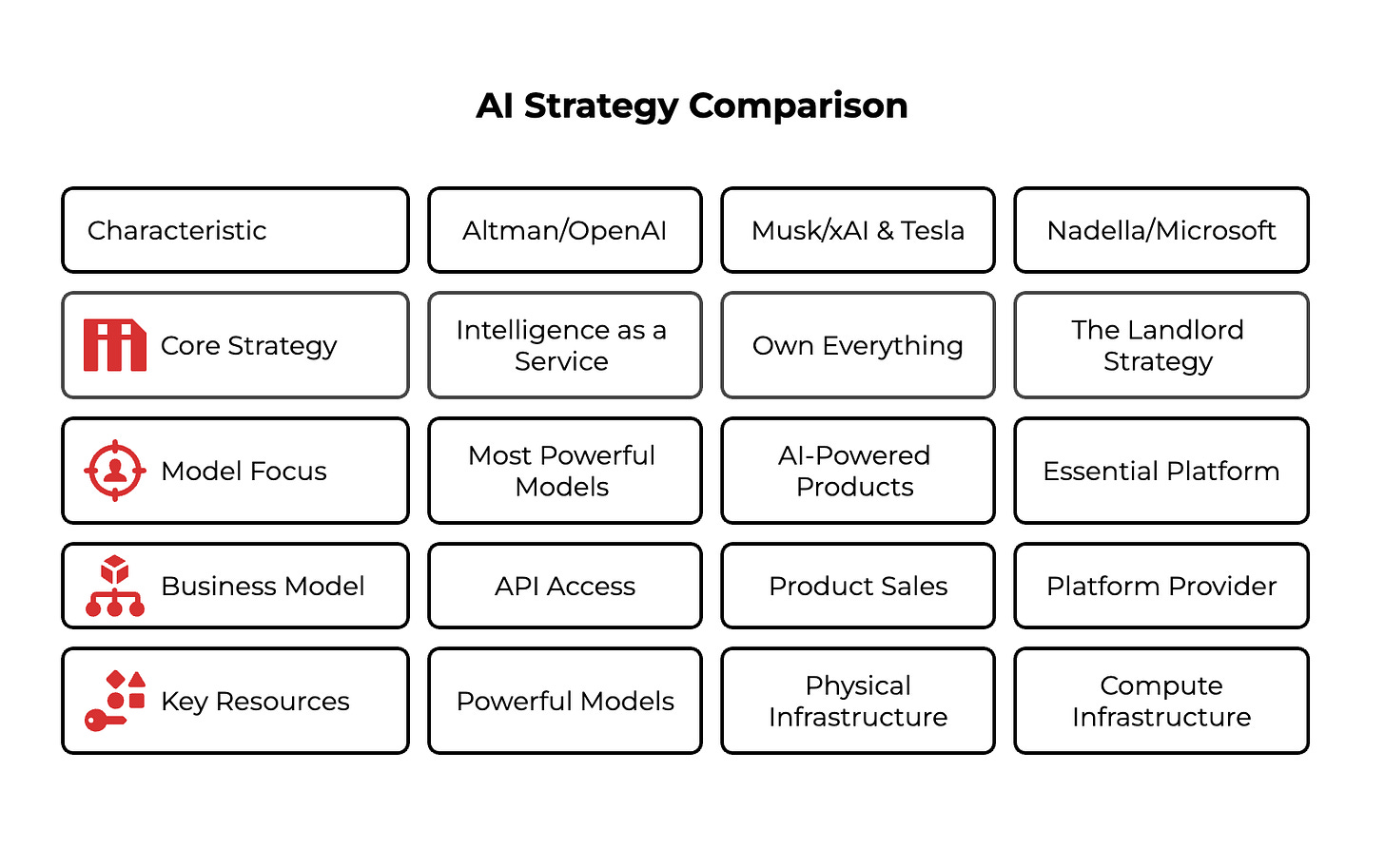The Real AI War: Three Strategies That Will Shape Your Future
While everyone debates which chatbot is better, the real battle is being fought with billion-dollar chip orders
Hey Adopter,
I just watched Sam Altman, Satya Nadella, and Elon Musk speak at Y Combinator events this past week. Here's what you'll get from this analysis: where these three AI titans actually agree, where they completely diverge, and what their strategies mean for your business decisions right now.
Forget the flashy demos and marketing speak. The real AI war isn't happening in conference rooms or on Twitter. It's happening in the most boring place imaginable: procurement departments, where the world's biggest tech companies are placing orders for chips that cost more than most people's houses.
The numbers tell a story that no press release will ever admit. While we've been obsessing over which AI can write better emails, three tech titans have been quietly reshaping the entire industry through a simple but brutal strategy: buying all the intelligence-making machines.
The New Oil Rush Has Already Started
Here's what's actually happening behind the scenes. Meta has committed to acquiring 350,000 Nvidia H100 GPUs, each costing between $30,000 to $40,000. That's a $10+ billion bet on raw computational power.
Microsoft, through its partnership with OpenAI, has gone even bigger. Estimates suggest they're building compute capacity equivalent to 750,000 to 900,000 H100s.
These aren't just big numbers. They're declarations of war. Every one of these chips represents the ability to train models that could reshape entire industries.
The companies buying them aren't just building AI. They're building the exclusive right to build AI at scale. The era of garage-based AI breakthroughs is over. The future belongs to whoever can write the biggest checks to Nvidia.
Three Empires, Three Strategies
What's fascinating isn't just the scale of these investments. It's how differently each player is deploying their arsenal. The research reveals three completely different philosophies about what AI should actually do.
Altman's API Empire: Intelligence as a Service
OpenAI's strategy is deceptively simple: build the most powerful models and sell access through APIs. The constant stream of new releases isn't just innovation theater. GPT-4o, reasoning models, multimodal capabilities. It's a systematic effort to make every other AI development dependent on their infrastructure.
If OpenAI succeeds, your future AI strategy won't be about building models. It'll be about building the best workflows on top of their intelligence layer.
Musk's Vertical Integration: Own Everything
While others rent compute power, Musk bought 100,000 H100s for xAI and another 35,000 for Tesla. But here's the real kicker: Tesla's Optimus robot already uses xAI's Grok for voice interaction.
This isn't just corporate synergy. It's a completely different business model. Musk isn't selling access to AI. He's selling AI-powered products. The robot, the car, the rocket, all powered by intelligence he owns and controls.
While everyone else is building software, Musk is building the physical infrastructure of an AI-powered world.
Nadella's Platform Play: The Landlord Strategy
Microsoft's approach is the most sophisticated. They're not just building AI. They're becoming the essential platform that everyone else's AI runs on.
By providing the compute infrastructure for OpenAI while building AI into every Microsoft product, Nadella has positioned Microsoft as the indispensable utility provider for the AI economy. Microsoft isn't betting on a single AI application. They're betting on the entire ecosystem, collecting rent from everyone who participates.
The Capability Gap That Actually Matters
Here's where it gets interesting for your business. All three leaders agree on something that should terrify most companies: there's a massive "capability overhang" between what AI can theoretically do and what organizations can actually implement.
The bottleneck isn't the technology. It's everything else. Enterprise data silos, legacy IT systems, and corporate risk aversion are keeping companies from capturing AI's value.
While everyone debates model capabilities, the real competitive advantage is going to companies that can solve these boring, unglamorous integration problems. The winners won't be the companies with the best AI models. They'll be the companies with the best AI adoption strategies.
The Social Contract They're All Writing
Despite their fierce competition, all three leaders have converged on one critical point. AI must create "social surplus" to justify its massive resource consumption.
Nadella argues that AI needs "social permission" to use energy, meaning it must deliver measurable benefits to society. Even Musk has publicly agreed with this framework.
This isn't just corporate responsibility. It's strategic positioning. They're preemptively establishing the industry's "social contract" before regulators impose one on them.
The Real Choice You Need to Make
The research reveals something profound. We're not heading toward one AI future. We're heading toward three different futures, and you need to pick which one you're building for.
Future 1: The API Economy where intelligence is a utility you subscribe to, and competitive advantage comes from creative application and integration.
Future 2: The Physical Intelligence World where AI manifests in robots, autonomous vehicles, and smart physical infrastructure that reshapes how work gets done.
Future 3: The Platform-Mediated Future where a few dominant platforms control access to AI capabilities, and success comes from excelling within their ecosystems.
Each requires completely different strategies, skills, and business models.
What This Means for Your Next Move
The window for "wait and see" isn't just closing. It's already closed. The strategic positions are being established now, with acquisitions of specialized processors that will determine competitive dynamics for the next decade.
But here's the opportunity hiding in plain sight. While the titans battle for control of the intelligence layer, there's an enormous value creation opportunity in solving the messy human and organizational challenges that prevent AI adoption.
The companies that figure out how to bridge the capability overhang will capture massive value. How to actually get AI working in the real world, with real data, in real organizations. This matters regardless of which AI empire ultimately wins.
Stop obsessing over which model is best. Start obsessing over how to make any model work in the messy reality of your business.
Adapt & Create,
Kamil
Original Videos:
Sam Altman: The Future of OpenAI, ChatGPT's Origins, and Building AI Hardware
Satya Nadella: Microsoft's AI Bets, Hyperscaling, Quantum Computing Breakthroughs
Elon Musk: Digital Superintelligence, Multiplanetary Life, How to Be Useful







Great reading! I completely agree that people keep obsessing over which chatbot sounds smarter, while the real power move is buying up all the chips. It feels so much like watching the railroads in the 19th century or the early oil rush, where the infrastructure winners wrote the future rules. What fascinates me is how invisible this battle is to most people who think AI is just about clever code.